




A Sphere Of RestraintMy globe design is based on jute fibre ropes. It is impossible to ignore the narrative these objects speak to, particularly as historically many British rope-making firms were also managing slave voyages. Ropes like the ones on this globe could have been used to transport human cargo. Peopl... |
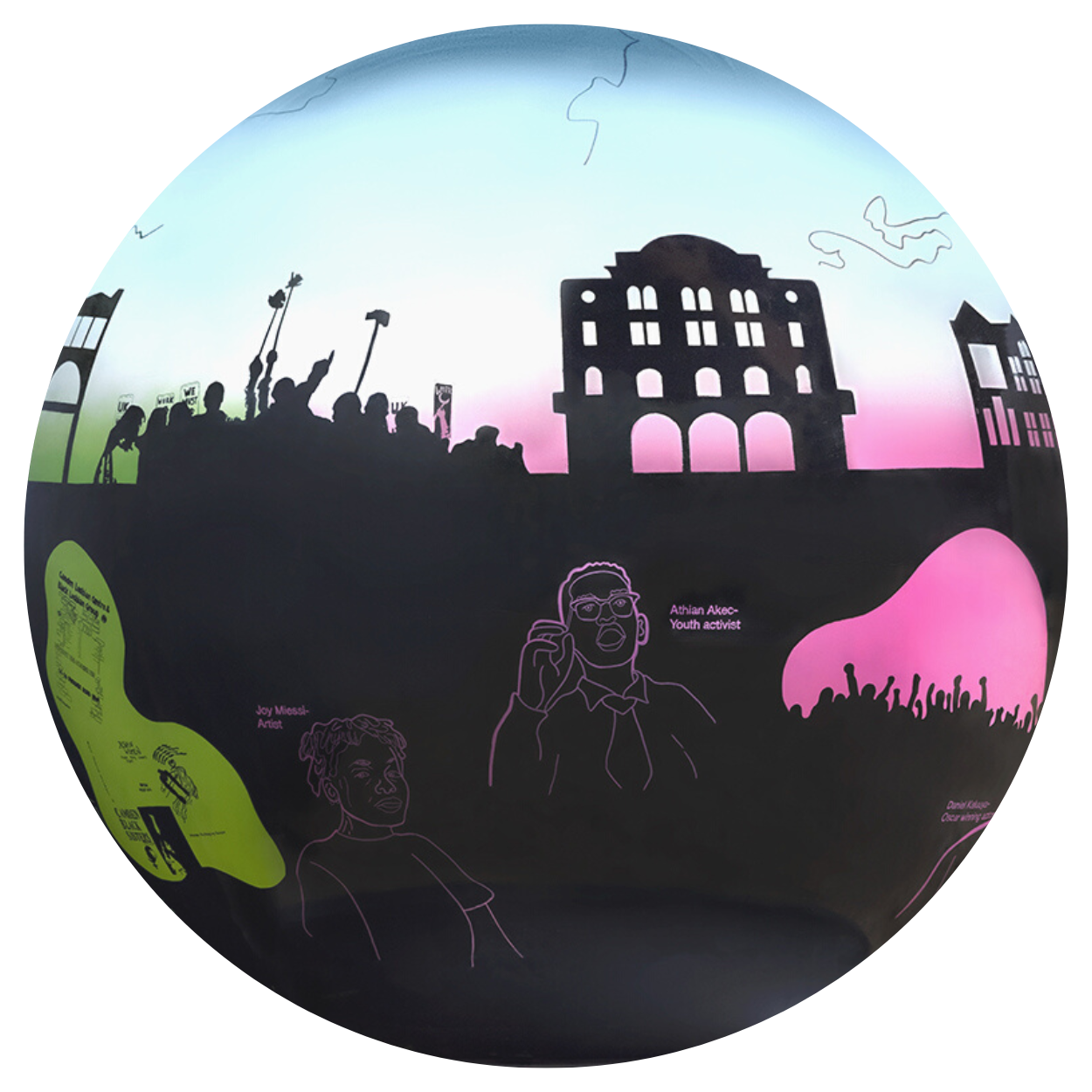
Beneath The SurfaceBeneath The Surface celebrates the contributions people of the African diaspora have made in Camden. For many people, the London borough is a bustling cultural zone where food markets can be seen alongside alternative music influences. While Camden has a rich history, much of its Black hist... |
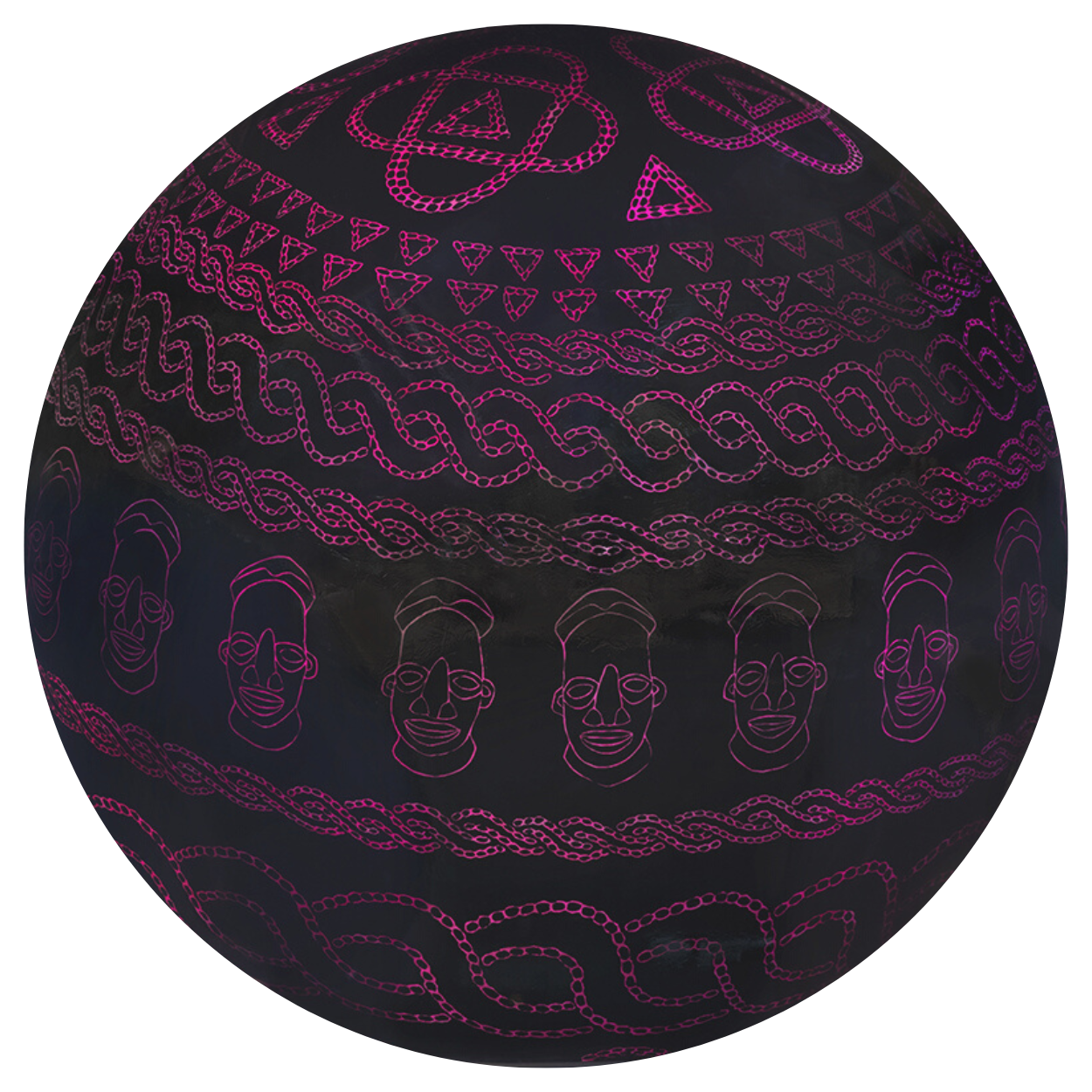
ToghuAs a queer artist with Cameroonian heritage, born in Cardiff, raised in Reading and the Ivory Coast, and now living in Glasgow, my personal Black history combines conflicting extremes of privilege, which have left me feeling unsettled in every culture. There is also the dizzying conflict of... |


| Goldington Crescent Gardens, NW1 1TU |
Sohaila’s design responds to the theme ‘The Reality of Being Enslaved’, which makes real the experience of those people who were enslaved, from their capture, captivity and voyage to lives and deaths enslaved in different contexts, places and generations.
My globe design is based on jute fibre ropes. It is impossible to ignore the narrative these objects speak to, particularly as historically many British rope-making firms were also managing slave voyages. Ropes like the ones on this globe could have been used to transport human cargo. People were enslaved and bought in exchange for goods shipped in the most vicious and inhumane ways across the Atlantic.
These objects hold on to the stories of violence, oppression, and inhumanity that are inexorably linked to the history of the Transatlantic Trade in Enslaved Africans. Not only are they witnesses to the brutal legacy of imperialism, they serve as lasting symbols of the exploitation and cruelty of European colonialists in their displays of power over the Black body.
Used to bind and tie the globe, they demonstrate the centrality of the Transatlantic Trade in Enslaved Africans and the vastness of a racist system that continues to restrain, tether and oppress bodies of colour that are viewed as ‘other’. The history of slavery touches every one of us in all corners of the world. The false reality established on the deceits and betrayals of imperialism must be challenged and retold.
In foregrounding the reality of being enslaved by using ropes to bind the globe I want to make clear the devastating and brutal legacy of slavery. It is our past and present, and the truth of this history must continue to be told and heard in full if we are to create a future that offers new possibilities; one that nurtures, supports and enables Brown and Black bodies to make meanings that demand changed social, cultural and political landscapes.
Sohaila Baluch is an artist and writer with a research based practice that draws from feminist strategies to unite craft traditions with fine art practice. Her work engages with durational practices, working with materials and processes that privilege the notion of gendered labour with a poetic intensity; to challenge the dominant aesthetics and discourse of Western patriarchy. Her work incorporates print, mixed media, installation, performance, text and moving image. Sohaila is a Phd Candidate at the Royal College of Art, London, UK. Her research is focussed on disrupting dominant narratives that tell racialised bodies they do not belong through a feminist activist practice that uses difference as a mode of resistance and re-imagining.
Sohaila’s design responds to the theme ‘The Reality of Being Enslaved’, which makes real the experience of those people who were enslaved, from their capture, captivity and voyage to lives and deaths enslaved in different contexts, places and generations.
My globe design is based on jute fibre ropes. It is impossible to ignore the narrative these objects speak to, particularly as historically many British rope-making firms were also managing slave voyages. Ropes like the ones on this globe could have been used to transport human cargo. People were enslaved and bought in exchange for goods shipped in the most vicious and inhumane ways across the Atlantic.
These objects hold on to the stories of violence, oppression, and inhumanity that are inexorably linked to the history of the Transatlantic Trade in Enslaved Africans. Not only are they witnesses to the brutal legacy of imperialism, they serve as lasting symbols of the exploitation and cruelty of European colonialists in their displays of power over the Black body.
Used to bind and tie the globe, they demonstrate the centrality of the Transatlantic Trade in Enslaved Africans and the vastness of a racist system that continues to restrain, tether and oppress bodies of colour that are viewed as ‘other’. The history of slavery touches every one of us in all corners of the world. The false reality established on the deceits and betrayals of imperialism must be challenged and retold.
In foregrounding the reality of being enslaved by using ropes to bind the globe I want to make clear the devastating and brutal legacy of slavery. It is our past and present, and the truth of this history must continue to be told and heard in full if we are to create a future that offers new possibilities; one that nurtures, supports and enables Brown and Black bodies to make meanings that demand changed social, cultural and political landscapes.
Sohaila Baluch is an artist and writer with a research based practice that draws from feminist strategies to unite craft traditions with fine art practice. Her work engages with durational practices, working with materials and processes that privilege the notion of gendered labour with a poetic intensity; to challenge the dominant aesthetics and discourse of Western patriarchy. Her work incorporates print, mixed media, installation, performance, text and moving image. Sohaila is a Phd Candidate at the Royal College of Art, London, UK. Her research is focussed on disrupting dominant narratives that tell racialised bodies they do not belong through a feminist activist practice that uses difference as a mode of resistance and re-imagining.


| St Pancras International - Inside, by Eurostar Arrivals |
The work of making racial justice a reality must be rooted in community – in our individual and collective experiences, hopes and contributions. POoR Collective's design was created in response to dialogue and workshops with local communities.
Beneath The Surface celebrates the contributions people of the African diaspora have made in Camden. For many people, the London borough is a bustling cultural zone where food markets can be seen alongside alternative music influences. While Camden has a rich history, much of its Black history dwells beneath the surface. Its powerful Black stories should be at the forefront of this popular tourist location not pushed underground.
With this in mind, Power Out of Restriction teamed up with the local community to develop a globe design that carefully speaks to the local Black community. Camden has a strong history of fighting for equality and is by far one of the most diverse areas in the country.
Beneath The Surface aims to highlight this while simultaneously educating people on local figures. The globe encompasses key Black people in the area such as Beryl Gilroy, Camden’s first Black headteacher; the borough’s new mayor Sabrina Francis; and Oscar-winning actor Daniel Kaluuya. The design consists of key movements, people, and places that Black people have influenced and changed for the better. Vibrant colours are juxtaposed against a bold background where silhouettes of key moments in Camden’s Black history can be found.
Beneath The Surface looks at the past and present of Camden while also looking ahead. It honours the local Black community and their stories while beginning to unpack hidden histories.
Power Out of Restriction (POoR) is a social enterprise that focuses on the development of communities through the elevation of young people. POoR sees the power of the younger generation and seeks to get young voices heard.
The work of making racial justice a reality must be rooted in community – in our individual and collective experiences, hopes and contributions. POoR Collective's design was created in response to dialogue and workshops with local communities.
Beneath The Surface celebrates the contributions people of the African diaspora have made in Camden. For many people, the London borough is a bustling cultural zone where food markets can be seen alongside alternative music influences. While Camden has a rich history, much of its Black history dwells beneath the surface. Its powerful Black stories should be at the forefront of this popular tourist location not pushed underground.
With this in mind, Power Out of Restriction teamed up with the local community to develop a globe design that carefully speaks to the local Black community. Camden has a strong history of fighting for equality and is by far one of the most diverse areas in the country.
Beneath The Surface aims to highlight this while simultaneously educating people on local figures. The globe encompasses key Black people in the area such as Beryl Gilroy, Camden’s first Black headteacher; the borough’s new mayor Sabrina Francis; and Oscar-winning actor Daniel Kaluuya. The design consists of key movements, people, and places that Black people have influenced and changed for the better. Vibrant colours are juxtaposed against a bold background where silhouettes of key moments in Camden’s Black history can be found.
Beneath The Surface looks at the past and present of Camden while also looking ahead. It honours the local Black community and their stories while beginning to unpack hidden histories.
Power Out of Restriction (POoR) is a social enterprise that focuses on the development of communities through the elevation of young people. POoR sees the power of the younger generation and seeks to get young voices heard.


| What 3 Words: sculpture.ozone.pizza |
Kialy’s design responds to the theme ‘Mother Africa’, which explores the richness and reality of Africa before the Transatlantic Trade in Enslaved Africans; the impact of the Transatlantic Trade in Enslaved Africans and European colonialism on Africa; and considers and celebrates Africa’s present and future.
As a queer artist with Cameroonian heritage, born in Cardiff, raised in Reading and the Ivory Coast, and now living in Glasgow, my personal Black history combines conflicting extremes of privilege, which have left me feeling unsettled in every culture. There is also the dizzying conflict of being bisexual whilst being raised in spaces filled with ambient homophobia, and growing up in the relatively liberal UK whilst knowing Cameroon’s homophobia to be an inherently colonialist, Christian and eurocentric conceit. The reasons for this internal conflict cannot be erased, but I would like to evolve them into something celebratory, both for myself, and for other queer Cameroonians.
My globe depicts an interpretation of Toghu cloth, the traditional textile of Cameroon. This is typically made of black velvet and richly embroidered in red, gold and white chain stitching. I have chosen to depict this embroidery in pink. Queerness will be literally embroidered into the fabric of Cameroon, forcing the viewer to grapple with the complexity of my community. I have also included a repeated motif of a carved wooden mask, which is based on a fourteenth century Cameroonian mask currently held in the British Museum. The presence of this mask, looted from Cameroon and currently held in Britain, raises questions about which colonial imports Cameroonians choose to uphold. In an idealised world, Cameroonian homophobia would be repatriated in exchange for its priceless cultural artefacts.
In the world we currently inhabit, I believe queer Cameroonians must carve out our own versions of Cameroonian identity. The black and pink patterned globe is intended to be visually bold, taking up all the space that queer Cameroonians often cannot safely fill. I hope that it will give queer Cameroonians throughout the diaspora a sense of reclaimed power.
Kialy is an interdisciplinary artist and designer based in Glasgow. Textiles, costume and animation inform her practice, which combines and contrasts hand and digital techniques.
Kialy’s design responds to the theme ‘Mother Africa’, which explores the richness and reality of Africa before the Transatlantic Trade in Enslaved Africans; the impact of the Transatlantic Trade in Enslaved Africans and European colonialism on Africa; and considers and celebrates Africa’s present and future.
As a queer artist with Cameroonian heritage, born in Cardiff, raised in Reading and the Ivory Coast, and now living in Glasgow, my personal Black history combines conflicting extremes of privilege, which have left me feeling unsettled in every culture. There is also the dizzying conflict of being bisexual whilst being raised in spaces filled with ambient homophobia, and growing up in the relatively liberal UK whilst knowing Cameroon’s homophobia to be an inherently colonialist, Christian and eurocentric conceit. The reasons for this internal conflict cannot be erased, but I would like to evolve them into something celebratory, both for myself, and for other queer Cameroonians.
My globe depicts an interpretation of Toghu cloth, the traditional textile of Cameroon. This is typically made of black velvet and richly embroidered in red, gold and white chain stitching. I have chosen to depict this embroidery in pink. Queerness will be literally embroidered into the fabric of Cameroon, forcing the viewer to grapple with the complexity of my community. I have also included a repeated motif of a carved wooden mask, which is based on a fourteenth century Cameroonian mask currently held in the British Museum. The presence of this mask, looted from Cameroon and currently held in Britain, raises questions about which colonial imports Cameroonians choose to uphold. In an idealised world, Cameroonian homophobia would be repatriated in exchange for its priceless cultural artefacts.
In the world we currently inhabit, I believe queer Cameroonians must carve out our own versions of Cameroonian identity. The black and pink patterned globe is intended to be visually bold, taking up all the space that queer Cameroonians often cannot safely fill. I hope that it will give queer Cameroonians throughout the diaspora a sense of reclaimed power.
Kialy is an interdisciplinary artist and designer based in Glasgow. Textiles, costume and animation inform her practice, which combines and contrasts hand and digital techniques.

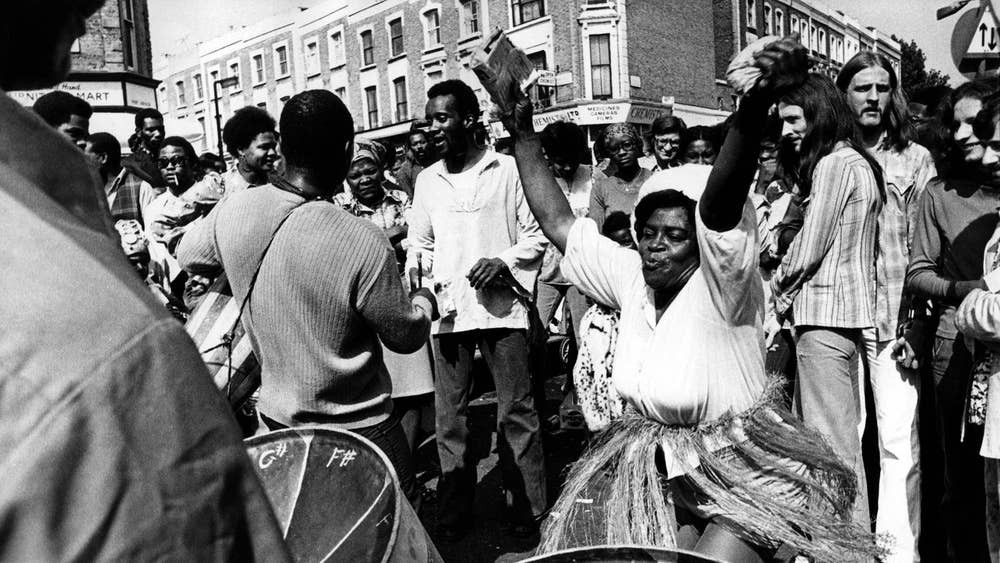
| 5 Judd Street, London, WC1H 9JE |
Formerly known as St Pancras Town Hall, on 30th January 1959 this building played host to the first of several indoor Caribbean carnivals aimed at celebrating Caribbean culture, music and dance. These indoor carnivals were the brainchild and work of the Trinidadian anti-racism activist Claudia Jones. Jones organised them in response to the hostility, discrimination, exclusion and racism experienced by Caribbean migrants to Britain. Regarding the event, which was televised by the BBC, Jones stated ‘a people’s art is the genesis of their freedom’. Carnival in the Caribbean had emerged from the 18th century masquerade balls held by European plantation owners before the Christian season of Lent. The balls were later adapted by the African population to celebrate emancipation from 1838 onwards. Carnival was used as a means to express cultural identity and beliefs and to make satirical commentary.
Formerly known as St Pancras Town Hall, on 30th January 1959 this building played host to the first of several indoor Caribbean carnivals aimed at celebrating Caribbean culture, music and dance. These indoor carnivals were the brainchild and work of the Trinidadian anti-racism activist Claudia Jones. Jones organised them in response to the hostility, discrimination, exclusion and racism experienced by Caribbean migrants to Britain. Regarding the event, which was televised by the BBC, Jones stated ‘a people’s art is the genesis of their freedom’. Carnival in the Caribbean had emerged from the 18th century masquerade balls held by European plantation owners before the Christian season of Lent. The balls were later adapted by the African population to celebrate emancipation from 1838 onwards. Carnival was used as a means to express cultural identity and beliefs and to make satirical commentary.

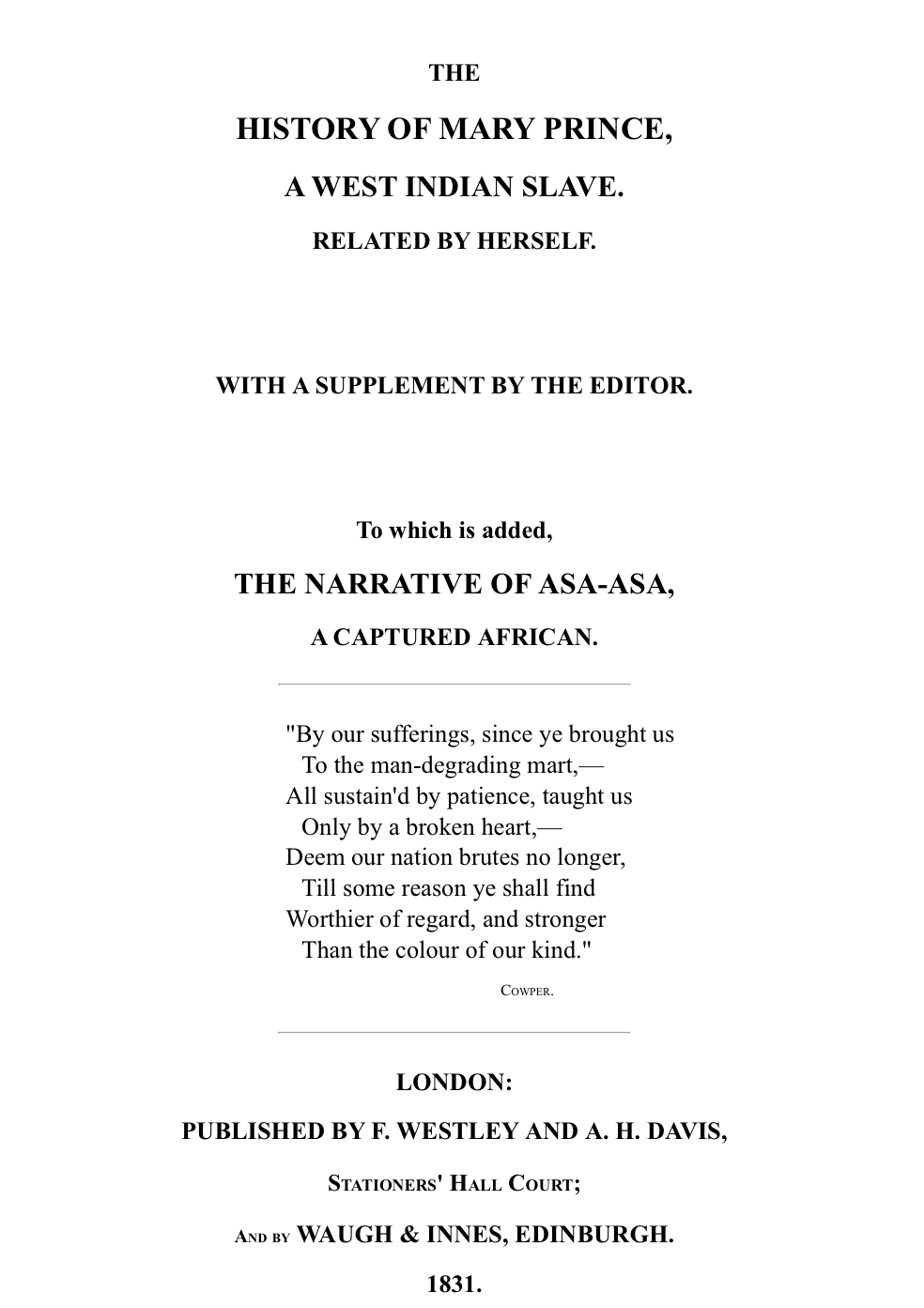
| Leigh Street |
This was the site of the Wood family home in London which Mary Prince, an enslaved African woman had been brought to from Antigua in 1828. Mary later escaped and made acquaintances with Thomas Pringle, the secretary to the Anti-Slavery society. She told her story in an autobiographical book that detailed the horrific experiences of her enslavement. Entitled The History of Mary Prince, A West Indian Slave the book played a major role in boosting public support for the abolition of slavery and was the first account of slavery from the first-hand perspective of an African woman.
This was the site of the Wood family home in London which Mary Prince, an enslaved African woman had been brought to from Antigua in 1828. Mary later escaped and made acquaintances with Thomas Pringle, the secretary to the Anti-Slavery society. She told her story in an autobiographical book that detailed the horrific experiences of her enslavement. Entitled The History of Mary Prince, A West Indian Slave the book played a major role in boosting public support for the abolition of slavery and was the first account of slavery from the first-hand perspective of an African woman.

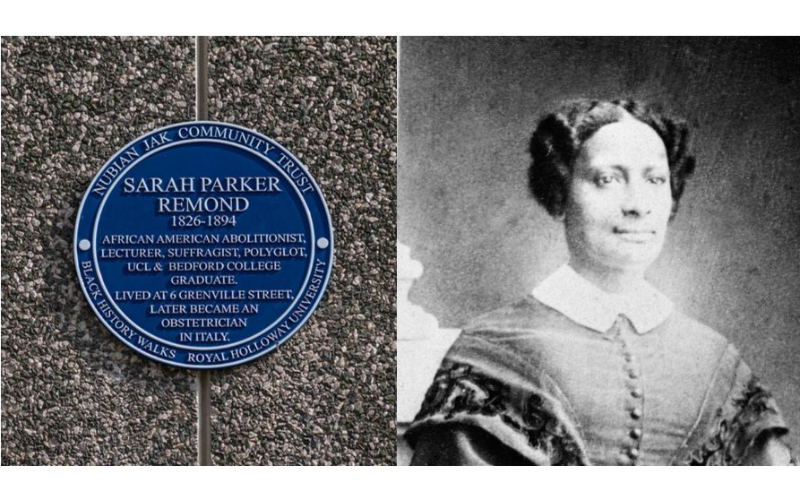
| Grenville Street (The plaque is situated directly opposite where Sarah Parker Remond lived at Bedford College at 6 Grenville Street) |
In October 1859, the transatlantic, radical, Black American abolitionist, Sarah Parker Remond enrolled at Bedford College (today known as Royal Holloway) to take up studies in numerous subjects, including Latin, French and Arithmetic, becoming the first Black person to do so. Whilst a student at the college she lived at 6 Grenville Street. Remond was born in Salem, Massachusetts, USA into a free Black family of abolitionists. Despite the northern states being officially ‘free’, Remond experienced racial discrimination and segregation. She became a leading voice in opposition to racial injustice, becoming a powerful lecturer and fundraiser for the cause of abolition. In her early 30s, she eventually brought her message to Britain and toured the country to highlight the horrors of slavery and injustices of racism in her homeland and build support for her cause. Remond later moved to Italy where she married and became a doctor.
Image: Blue Nubian Jak plaque, credit PAL Associates, Right: 'image of Sarah Parker Remond', credit wikicommons
In October 1859, the transatlantic, radical, Black American abolitionist, Sarah Parker Remond enrolled at Bedford College (today known as Royal Holloway) to take up studies in numerous subjects, including Latin, French and Arithmetic, becoming the first Black person to do so. Whilst a student at the college she lived at 6 Grenville Street. Remond was born in Salem, Massachusetts, USA into a free Black family of abolitionists. Despite the northern states being officially ‘free’, Remond experienced racial discrimination and segregation. She became a leading voice in opposition to racial injustice, becoming a powerful lecturer and fundraiser for the cause of abolition. In her early 30s, she eventually brought her message to Britain and toured the country to highlight the horrors of slavery and injustices of racism in her homeland and build support for her cause. Remond later moved to Italy where she married and became a doctor.
Image: Blue Nubian Jak plaque, credit PAL Associates, Right: 'image of Sarah Parker Remond', credit wikicommons

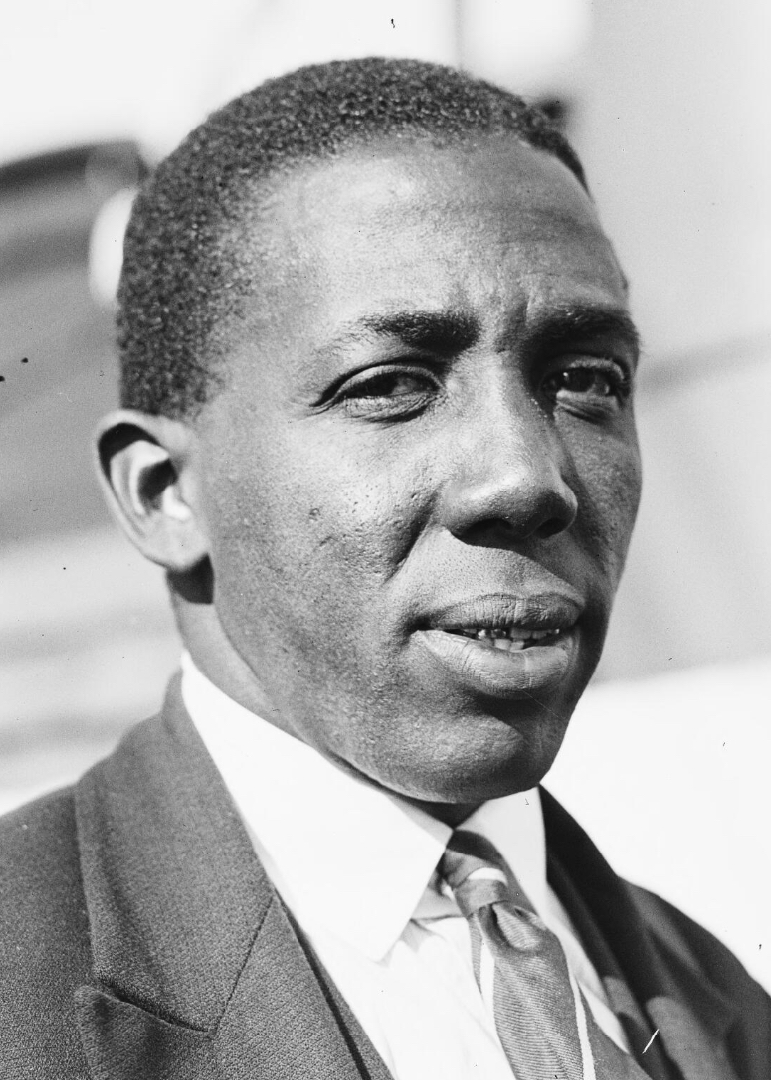
| 61-66 Russell Square, London, WC1B 5BB |
Born in 1901, Sir Learie Constantine was a Trinidadian activist, cricketer, lawyer and politician. Learie played cricket with distinction for both the West Indies and the Lincolnshire team of Nelson, becoming one of the most well paid sportspeople of his time. In 1943, he took leave from his position as Welfare Officer at the Ministry of Labour and National Service to captain the West Indian cricket team in a charity match. Having booked accommodation at the Imperial Hotel at Russell Square for himself and his family, on arrival they were met with racial discrimination and told in racially offensive terms that they could not stay. Learie successful sued the hotel for breach of contract. The case is considered an important step on the road to the passing of the Race Relations Act 1965, the board of which Learie was appointed to, in order to investigate cases of racist incidents.
Image By National Library of Australia - https://nla.gov.au/nla.obj-162802066, Public Domain, https://commons.wikimedia.org/w/index.php?curid=69850404
Born in 1901, Sir Learie Constantine was a Trinidadian activist, cricketer, lawyer and politician. Learie played cricket with distinction for both the West Indies and the Lincolnshire team of Nelson, becoming one of the most well paid sportspeople of his time. In 1943, he took leave from his position as Welfare Officer at the Ministry of Labour and National Service to captain the West Indian cricket team in a charity match. Having booked accommodation at the Imperial Hotel at Russell Square for himself and his family, on arrival they were met with racial discrimination and told in racially offensive terms that they could not stay. Learie successful sued the hotel for breach of contract. The case is considered an important step on the road to the passing of the Race Relations Act 1965, the board of which Learie was appointed to, in order to investigate cases of racist incidents.
Image By National Library of Australia - https://nla.gov.au/nla.obj-162802066, Public Domain, https://commons.wikimedia.org/w/index.php?curid=69850404


| 61-65 Great Queen Street, London, WC2B 5DA |
The Connaught Rooms stand on the site of the former Freemasons’ Tavern which stood between 1775 and 1909. This is where, in 1840, part of the World Anti-Slavery Convention took place including it’s first meeting on 12th June of that year. The convention had been organised by the British and Foreign Anti-Slavery Society with a number of issues to be discussed on the agenda, including slavery and the slave trade in the southern states of the US and the treatment of enslaved people in the US and emancipated people in British colonies. Among the delegates were a number of abolitionists of African descent including Charles Lenox Remond (older brother of Sarah Parker Remond) from the US, Henry Beckford and Edward Barrett from Jamaica; Samuel Prescod from Barbados, L.C. Lecesne from Jamaica or Haiti and Jean-Baptiste Linstant from Haiti. Some of these men are depicted in a painting entitled The Anti-Slavery Society Convention, 1840 by Benjamin Robert Haydon which hangs in the National Portrait Gallery.
Image By John Nixon (c.1750-1818) - http://www.freemasonry.london.museum/resources/history-of-freemasons-hall/, Public Domain, https://commons.wikimedia.org/w/index.php?curid=50236843
The Connaught Rooms stand on the site of the former Freemasons’ Tavern which stood between 1775 and 1909. This is where, in 1840, part of the World Anti-Slavery Convention took place including it’s first meeting on 12th June of that year. The convention had been organised by the British and Foreign Anti-Slavery Society with a number of issues to be discussed on the agenda, including slavery and the slave trade in the southern states of the US and the treatment of enslaved people in the US and emancipated people in British colonies. Among the delegates were a number of abolitionists of African descent including Charles Lenox Remond (older brother of Sarah Parker Remond) from the US, Henry Beckford and Edward Barrett from Jamaica; Samuel Prescod from Barbados, L.C. Lecesne from Jamaica or Haiti and Jean-Baptiste Linstant from Haiti. Some of these men are depicted in a painting entitled The Anti-Slavery Society Convention, 1840 by Benjamin Robert Haydon which hangs in the National Portrait Gallery.
Image By John Nixon (c.1750-1818) - http://www.freemasonry.london.museum/resources/history-of-freemasons-hall/, Public Domain, https://commons.wikimedia.org/w/index.php?curid=50236843

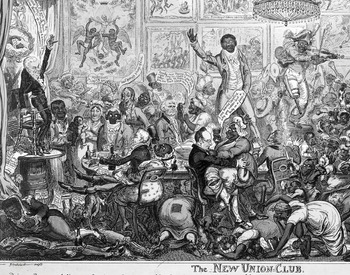
| Dudley Court, 36 Endell Street, London, WC2H 9RF |
In the 18th century, the area of London known as St Giles was home to a multi-cultural community of poor people including veteran soldiers and sailors as well as formerly enslaved Africans. Collectively this community were referred to as the ‘St Giles Blackbirds’ and were part of the wider community in London known as the ‘Black Poor’. One resident of St Giles at this time was Billy Waters, former Royal Naval sailor who was injured in the line of duty and later settled in London, supporting himself and his family by busking on the streets around the West End. In his later years, illness and poverty meant that Billy Waters entered the St Giles Workhouse.
Another resident of St Giles around the same time as Billy Waters was the Jamaican radical abolitionist Robert Wedderburn. Born to an enslaved African mother and slaveholding father, Wedderburn was born free, though was brought up among the brutality of the West Indian slave system. When he moved to Britain following a brief stint in the Royal Navy, he became a staunch abolitionist and a fierce advocate for reform of the systems oppressing working class people.
In the 18th century, the area of London known as St Giles was home to a multi-cultural community of poor people including veteran soldiers and sailors as well as formerly enslaved Africans. Collectively this community were referred to as the ‘St Giles Blackbirds’ and were part of the wider community in London known as the ‘Black Poor’. One resident of St Giles at this time was Billy Waters, former Royal Naval sailor who was injured in the line of duty and later settled in London, supporting himself and his family by busking on the streets around the West End. In his later years, illness and poverty meant that Billy Waters entered the St Giles Workhouse.
Another resident of St Giles around the same time as Billy Waters was the Jamaican radical abolitionist Robert Wedderburn. Born to an enslaved African mother and slaveholding father, Wedderburn was born free, though was brought up among the brutality of the West Indian slave system. When he moved to Britain following a brief stint in the Royal Navy, he became a staunch abolitionist and a fierce advocate for reform of the systems oppressing working class people.

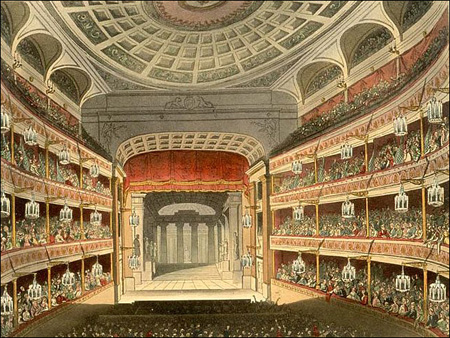
| Royal Opera House, Bow Street, London, WC2E 9DD |
Formerly known as Covent Garden Theatre, in 1833 the Black American actor Ira Aldridge took to the stage here to perform in the role of Othello. In a similar way to his performance at the Coburg Theatre (today’s The Old Vic) 8 years earlier, audiences seemed to love him but critics were vitriolic in their racist abuse. They objected to his playing alongside a white actress in the role of Desdemona. The theatre cancelled his remaining performances so in total he only performed for 2 nights.
The formerly enslaved American abolitionist and speaker Frederick Douglas spoke here in 1846 at the The World Temperance Convention. Advocates for temperance, like Douglas, believed that consumption of alcohol was behind many of society’s problems. Douglas had been travelling throughout the UK and Ireland to speak about the horrors of enslavement and to gather support for abolition. He used his speech at the Temperance Convention to also talk about ending slavery and that he believed temperance societies needed to be inclusive of Black people.
Image “New Covent Garden Theatre” by Thomas Rowlandson and Augustus Pugin, engraved by John Bluck, from The Microcosm of London published by Ruldolph Ackermann, 1810.
Formerly known as Covent Garden Theatre, in 1833 the Black American actor Ira Aldridge took to the stage here to perform in the role of Othello. In a similar way to his performance at the Coburg Theatre (today’s The Old Vic) 8 years earlier, audiences seemed to love him but critics were vitriolic in their racist abuse. They objected to his playing alongside a white actress in the role of Desdemona. The theatre cancelled his remaining performances so in total he only performed for 2 nights.
The formerly enslaved American abolitionist and speaker Frederick Douglas spoke here in 1846 at the The World Temperance Convention. Advocates for temperance, like Douglas, believed that consumption of alcohol was behind many of society’s problems. Douglas had been travelling throughout the UK and Ireland to speak about the horrors of enslavement and to gather support for abolition. He used his speech at the Temperance Convention to also talk about ending slavery and that he believed temperance societies needed to be inclusive of Black people.
Image “New Covent Garden Theatre” by Thomas Rowlandson and Augustus Pugin, engraved by John Bluck, from The Microcosm of London published by Ruldolph Ackermann, 1810.


| Trafalgar Square |
Four bronze reliefs, depicting battles that Vice Admiral Horatio Nelson was involved in decorate the four sides of the pedestal of Nelson’s column. The south facing relief is entitled ‘The Death of Nelson at Trafalgar’ and captures the moment that Nelson was mortally wounded in the battle with his crew coming to his aid.
Standing on the left of the relief is a Black sailor. This is believed to be an African born man called George Ryan who was recruited into the navy in west Africa in his early 20s. There is a long history of Black men serving in the Royal Navy. Some of these seamen were highly skilled Africans recruited or enslaved in their homelands to provide a substitute for British sailors who had died or deserted service. Others had been born into slavery in the Americas and were offered freedom in exchange for their service.
Four bronze reliefs, depicting battles that Vice Admiral Horatio Nelson was involved in decorate the four sides of the pedestal of Nelson’s column. The south facing relief is entitled ‘The Death of Nelson at Trafalgar’ and captures the moment that Nelson was mortally wounded in the battle with his crew coming to his aid.
Standing on the left of the relief is a Black sailor. This is believed to be an African born man called George Ryan who was recruited into the navy in west Africa in his early 20s. There is a long history of Black men serving in the Royal Navy. Some of these seamen were highly skilled Africans recruited or enslaved in their homelands to provide a substitute for British sailors who had died or deserted service. Others had been born into slavery in the Americas and were offered freedom in exchange for their service.

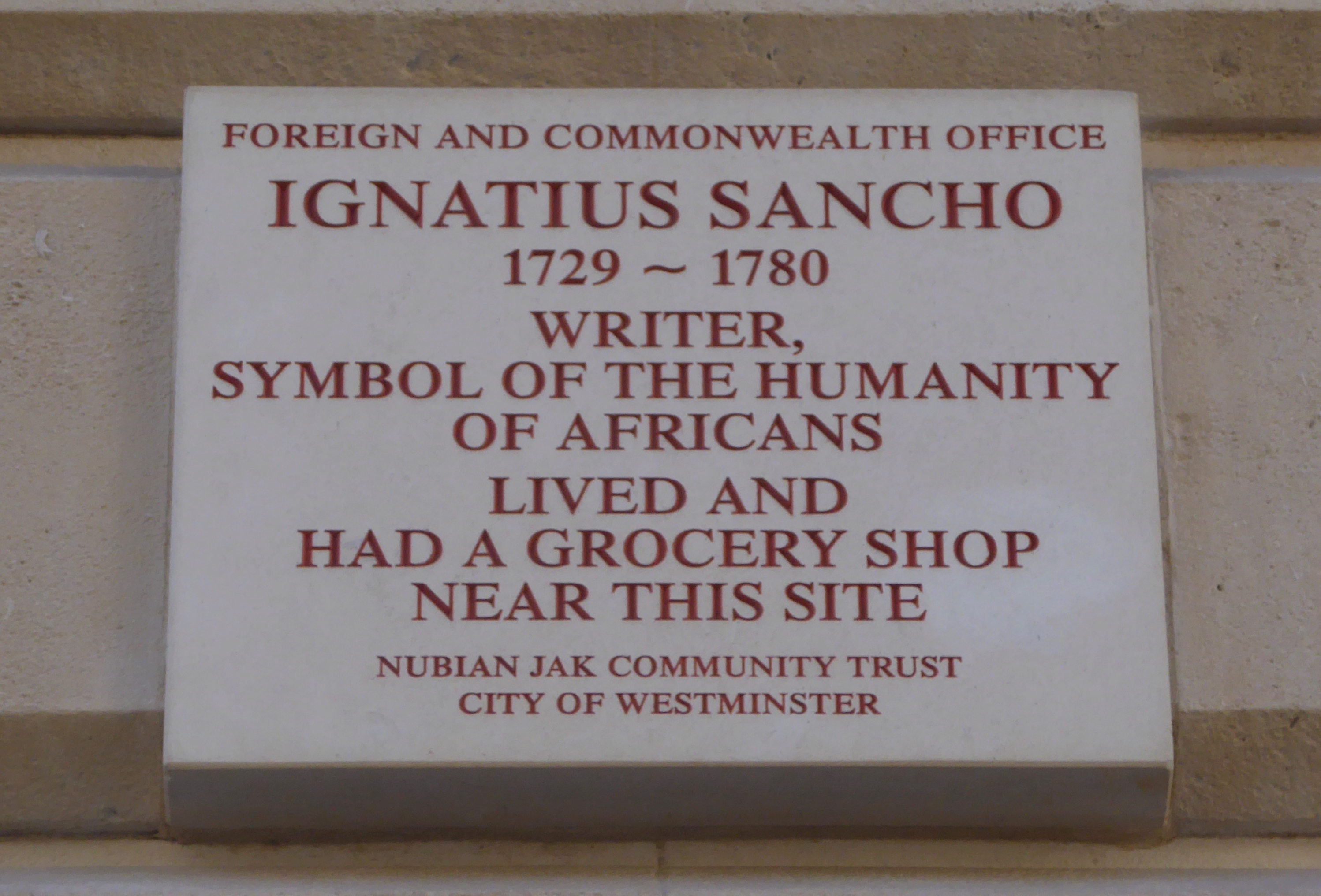
| King Charles Street, London, SW1 |
In 1774, the formerly enslaved Ignatius Sancho and his wife Anne Osborne, opened a grocery shop on this site. As a property-owning man, Ignatius Sancho became eligible to vote in a general election, which he did later that year, becoming the first Black person to cast a vote in Britain. Ignatius enjoyed a number of pursuits such as writing stage plays, poetry and music - particularly minuets - which were very popular at ballroom dances at the time. Sancho was a prolific writer, penning many letters to friends and newspapers. He wrote about politics, art, literature, society and denounced the greed and wickedness that lay behind slavery.
Image Courtesy of Ethan Doyle White
In 1774, the formerly enslaved Ignatius Sancho and his wife Anne Osborne, opened a grocery shop on this site. As a property-owning man, Ignatius Sancho became eligible to vote in a general election, which he did later that year, becoming the first Black person to cast a vote in Britain. Ignatius enjoyed a number of pursuits such as writing stage plays, poetry and music - particularly minuets - which were very popular at ballroom dances at the time. Sancho was a prolific writer, penning many letters to friends and newspapers. He wrote about politics, art, literature, society and denounced the greed and wickedness that lay behind slavery.
Image Courtesy of Ethan Doyle White

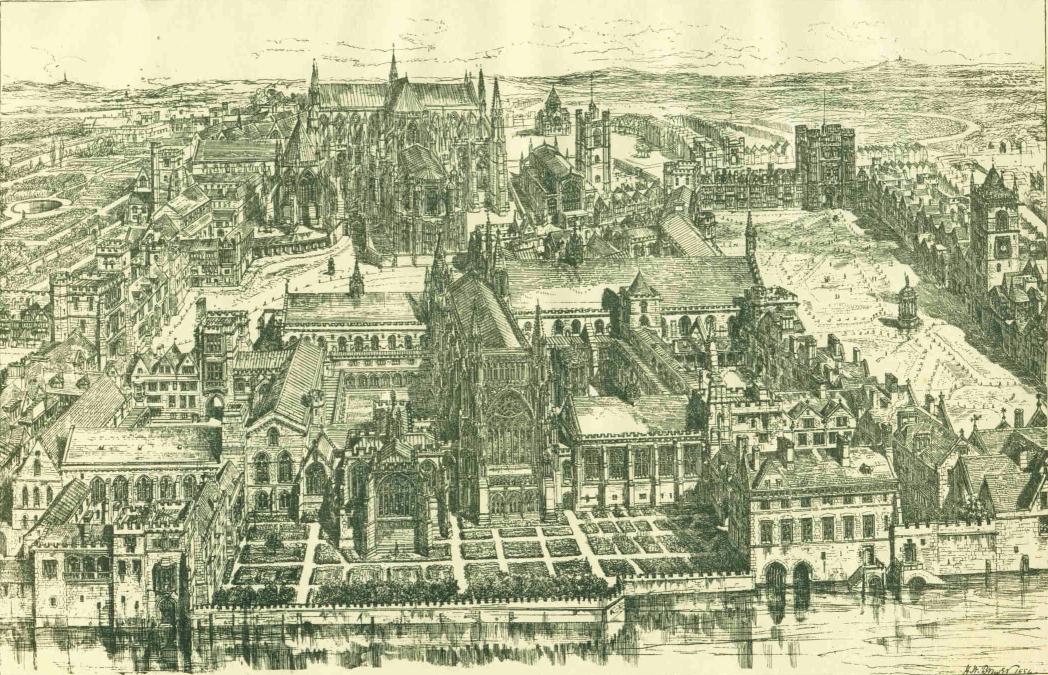
| Parliament Square |
The Somerset v Stewart case of 1772 concerned the right of an enslaved African man called James Somerset not to be forcibly deported from England to the colonies of the Caribbean against his will. Presided over by the Lord Chief Justice, William Murray in the Court of King’s Bench in Westminster Hall, there were five months of hearings and an additional month of deliberation before he made a decision. The Somerset case became a cause célèbre and was heavily publicised in the press, garnering the attention of the Black community of Britain and slaveholders alike. In the end, Mansfield ruled that Somerset could not be sent away from the country against his will. He also gave the legal opinion that slavery could only be supported in England and Wales by an act of Parliament - in other words, it had to be legislated for.
Image by H J Brewer, First Published in The Builder magazine, 1884 / Republished: parliament.uk
The Somerset v Stewart case of 1772 concerned the right of an enslaved African man called James Somerset not to be forcibly deported from England to the colonies of the Caribbean against his will. Presided over by the Lord Chief Justice, William Murray in the Court of King’s Bench in Westminster Hall, there were five months of hearings and an additional month of deliberation before he made a decision. The Somerset case became a cause célèbre and was heavily publicised in the press, garnering the attention of the Black community of Britain and slaveholders alike. In the end, Mansfield ruled that Somerset could not be sent away from the country against his will. He also gave the legal opinion that slavery could only be supported in England and Wales by an act of Parliament - in other words, it had to be legislated for.
Image by H J Brewer, First Published in The Builder magazine, 1884 / Republished: parliament.uk


| St Margaret Street, London SW1P 3JX |
Phillis Wheatley was a pioneer of African American literature. Sold into slavery at 8 years of age and bought by the Wheatley family of Boston, Massachusetts, she was named after the slave ship -The Phillis - which had brought her to America from the area around present day Senegal or The Gambia, where she was born. As a child, Phillis showed a prodigious talent for languages and wrote a whole book of poetry by the age of 20. In 1773 she travelled to London where her collection of poetry was published by Archibald Bell Booksellers in Aldgate, becoming the very first literary work by a Black woman to be published in Britain. Whilst promoting her book, Phillis met the abolitionist Granville Sharp who took her on a sightseeing tour of London including a visit to Westminster Abbey.
Olaudah Equiano, a formerly enslaved man and leading abolitionist of the 18th century was baptised in St Margaret’s Church in 1759. He was born the son of an Igbo elder in what is today south-eastern Nigeria. As a young boy of about 11, he was captured, enslaved and trafficked to Barbados and then Virginia in colonial America. After being sold several times, Olaudah was eventually able to purchase his freedom for the price that had been paid for him and went on to become one of the leading figures in the abolition of the slave trade becoming a co-founder of the Black abolitionist pressure group known as the Sons of Africa and writing the influential and best-selling autobiography The Interesting Narrative of the Life of Olaudah Equiano or Gustavus Vassa the African.
Image By Ermell - Own work, CC BY-SA 4.0
Phillis Wheatley was a pioneer of African American literature. Sold into slavery at 8 years of age and bought by the Wheatley family of Boston, Massachusetts, she was named after the slave ship -The Phillis - which had brought her to America from the area around present day Senegal or The Gambia, where she was born. As a child, Phillis showed a prodigious talent for languages and wrote a whole book of poetry by the age of 20. In 1773 she travelled to London where her collection of poetry was published by Archibald Bell Booksellers in Aldgate, becoming the very first literary work by a Black woman to be published in Britain. Whilst promoting her book, Phillis met the abolitionist Granville Sharp who took her on a sightseeing tour of London including a visit to Westminster Abbey.
Olaudah Equiano, a formerly enslaved man and leading abolitionist of the 18th century was baptised in St Margaret’s Church in 1759. He was born the son of an Igbo elder in what is today south-eastern Nigeria. As a young boy of about 11, he was captured, enslaved and trafficked to Barbados and then Virginia in colonial America. After being sold several times, Olaudah was eventually able to purchase his freedom for the price that had been paid for him and went on to become one of the leading figures in the abolition of the slave trade becoming a co-founder of the Black abolitionist pressure group known as the Sons of Africa and writing the influential and best-selling autobiography The Interesting Narrative of the Life of Olaudah Equiano or Gustavus Vassa the African.
Image By Ermell - Own work, CC BY-SA 4.0

Login or Register to track the Globes you visit for chance to win a FREE copy of The World Reimagined book!
Find Out More


Artist Globe |
Learning Globe |
Points of Interest |